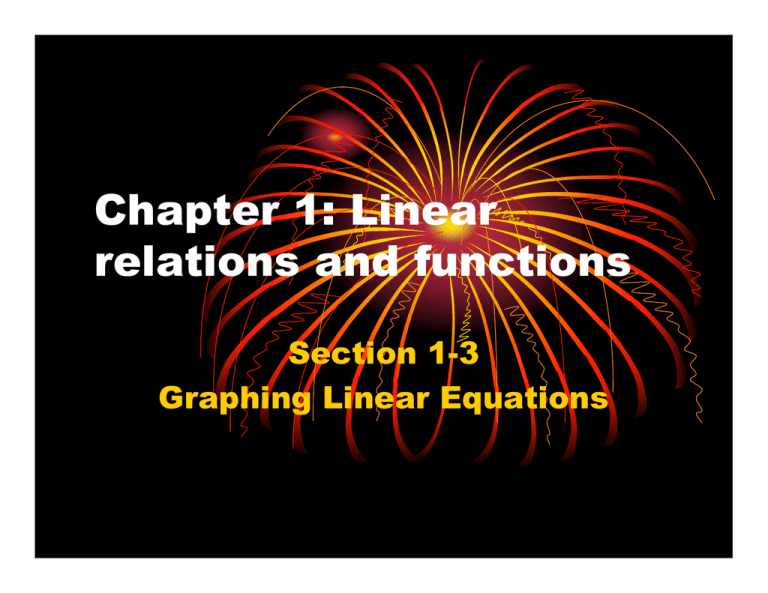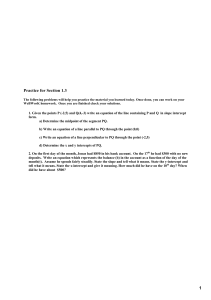Chapter 1: Linear relations and functions Section 1-3 Graphing Linear Equations
advertisement

Chapter 1: Linear relations and functions Section 1-3 Graphing Linear Equations . m= Some Vocabulary y2 − y1 x2 − x1 If x1 = x2 ( a vertical line), then there is no slope If y1 = y2 ( a horizontal line), then the slope is 0 • Standard Form Ax +By +C=0 • Slope-intercept form y= mx +b where m is the slope and b is the y intercept • X intercept is the point where the line crosses the x axis m= y2 − y1 x2 − x1 y2 − y1 x2 − x1 If x1 = x2 ( a vertical line), then there is no slope If y1 = y2 ( a horizontal line), then the slope is 0 m= If x1 = x2 ( a vertical line), then there is no slope If y1 = y2 ( a horizontal line), then the slope is 0 • Y intercept is the point where the line crosses the y axis • Slope is the ratio of the change in the ordinates of the points (Y) over the change in the corresponding abscissas (X). Slope is constant for the line. It is written as y 2 − y1 m = x 2 − x1 If x 1 = x 2 ( a vertical line), then there is no slope If y 1 = y 2 ( a horizontal then the slope is 0 line), Graphing a linear equation • Set up a table of values • Choose three values of the independent variable (x) • Find the corresponding y that makes the equation true • Plot the ordered pairs • The graph must be a line! Types of slopes • Positive slope means the line is rising • Negative slope means the line is descending • Zero slope means the line is a horizontal line • No slope (undefined) means the line is a vertical line. Graphing a linear equation using the slope and y intercept • Another way to graph a linear equation is to write the equation in slope intercept form ( y= mx +b) . One of the points is the y intercept b and is written as (0,b). • Use the slope to graph the second point and then draw the line. Linear Function A linear function is defined by f (x)= mx+b where m and b are real numbers. Values of x for which f (x) = 0 are called zeros of the function f. The zeros of the function are the x intercepts. In the case where m=0 (horizontal line), we have f (x) = b. This function is called a constant function and has no zeros UNLESS b=o. In the case of a vertical line, we do not have a function. Example # 1 Graph x + 2y -4=0 using the x and y intercepts. Find x intercept. Set y=0 then we have x + 2(0) -4 = 0 x-4 = 0 x=4 Therefore the x intercept is (4,0) Find the y intercept. Set x = 0, then we have 0 + 2y – 4 = 0 2y = 4 y=2 Therefore the y intercept is (0,2) Plotting the points and drawing the line, we have the graph below: Example #2 Find the zero of f (x) = -x -3 Set f (x) = 0 and solve for x 0 = -x-3 -3 = x -3 is the zero so the coordinates of one point is (-3,0) To find another point, set x =0. We find that when x =0 f (x)= -3. Thus (0, -3) is the second point. Plot and draw the line. HW#3 Section 1-3 PP. 24-25 #12,13,16,17,19,21,25,26,28,29, 33,40,42,43,46


